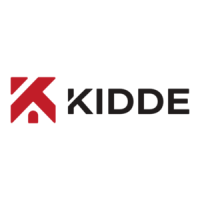General Information
April 2020 1-4 06-237619-001
Note: These instructions do not apply to personnel remaining in the enclosure after system
release during a fire if they are properly trained and equipped with self contained
breathing apparatus.
1-3.2 Agent Safety Concentrations
Kidde IGS agents are used at relatively high concentrations to extinguish fires, typically in the
range of 40 to 50% agent in air, or more. At a Kidde IGS agent concentration of 45%, the
residual oxygen concentration is 11.5%, compared with 21% in normal air. The principal health
risk from exposure to atmospheres having such low oxygen concentrations is "hypoxia,"
meaning insufficient oxygen concentration in the blood. The resulting guidelines for exposures
to atmospheres flooded with Kidde IGS agents are as follows:
• Unnecessary exposure to Kidde IGS agent resulting in low oxygen atmospheres shall be
avoided.
• The maximum exposure time in any case shall not exceed 5 minutes. See NFPA 2001 2015
Edition, table 5.5.3.3 for atmospheric correction factors that shall be considered when de-
termining the design concentrations.
• For systems that must meet NFPA standards, a pre-discharge alarm and discharge delay
shall be provided in accordance with the provisions of NFPA 2001, 2015 Edition.
• Unprotected personnel shall not enter the area during or after Agent discharge.
The following additional provisions shall apply:
• Kidde IGS that are designed to concentrations below 43 percent (corresponding to an ox-
ygen concentration of 12 percent, sea level equivalent of oxygen) shall be permitted where
means are provided to limit exposure to no longer than 5 minutes.
• Kidde IGS that are designed to concentrations between 43 and 52 percent (corresponding
to between 12 and 10 percent oxygen, sea level equivalent of oxygen) shall be permitted
where means are provided to limit exposure to no longer than 3 minutes.
• Kidde IGS that are designed to concentrations between 52 and 62 percent (corresponding
to between 10 and 8 percent oxygen, sea level equivalent of oxygen) shall be permitted
given the following:
– The space is normally unoccupied
– Where personnel could possibly be exposed, means are provided to limit the exposure
to less than 30 seconds
• Kidde IGS that are designed to concentrations above 62 percent (corresponding to 8 per-
cent oxygen or below, sea level equivalent of oxygen) shall be used only in unoccupied ar-
eas where personnel are not exposed to such oxygen depletion. The hazard in such cases
should be provided with the following safety measures.
–Pneumatic siren
–Pneumatic Time Delay
–Lockout Valve
–Caution Signs
CAUTION
During discharge, the agent passing through the system nozzles can emit a
noise at a level which could cause hearing injury.
CAUTION
Direct contact with the agent during discharge can cause frostbite burns to the
skin.

